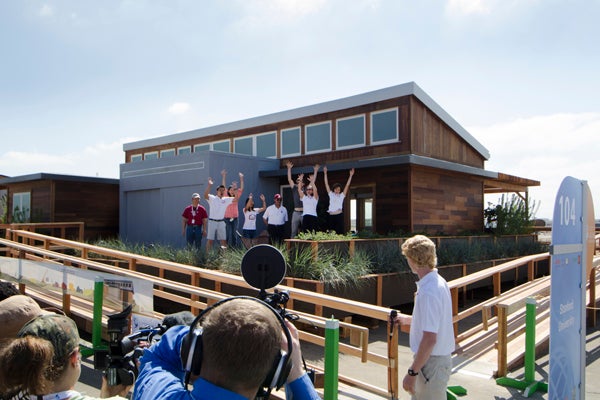|
October 18, 2013
Stanford's student-built home ranks high in green building competition
Stanford's first-ever entry in the Department of Energy-sponsored green building competition finished in fifth place, the top team among California-based competitors, and placed among the top five teams in six of the 10 judging categories. By Bjorn Carey

Stanford students participating for the first time in the Department of Energy's green building competition were pleased that their project finished fifth in the international competition. (Photo: Bjorn Carey)
Stanford students participated in the Department of Energy's Solar Decathlon green-building competition for the first time this year, but performed like seasoned veterans. The student-built Start.Home finished fifth among an international field of 19 similar projects.
The Solar Decathlon invites students to present their vision of an affordable, solar-powered home. Each house was judged on 10 criteria, such as engineering, energy balance and affordability, with each category worth 100 points toward an overall score.
Stanford students entered the contest with their Start.Home concept, a solar-powered modular home built around a Core unit that encapsulates the bulk of the home's electrical, plumbing and mechanical systems – an approach that helped make the home more energy efficient, and could also lead to assembly-line-like production of sustainable homes. The home also featured several design elements meant to guide homeowners toward self-selecting energy-efficient behaviors.
Team Austria, of the Vienna University of Technology, took the top honors, finishing with 951.9 points out of a possible 1,000. Competition was tight near the top, though: Stanford finished just 18.8 points out of first place.
"For a first-time competitor that was relatively short staffed, and competing against more experienced teams, I think fifth place is pretty damn good," said team leader Derek Ouyang, '13.
The Start.Home scored in the top five of six categories, though students were particularly proud of finishing tied for first in "Affordability" – their house cost $234,000, significantly less than any of the projects that finished ahead of Stanford – and tied for third in "Market Appeal."
The two results underscored the positive comments from the roughly 10,000 visitors who toured the house during the 10-day competition.
"We set out with a couple of major goals, and we didn't want to build an impossible vision of the future, but a very practical, feasible direction for the industry," Ouyang said. "We valued affordability and market appeal the most from the start. Doing well in those contests is among our proudest achievements."
The competition was held in Irvine, Calif., which inspired the team to design a home that they believed would fit the environmental and lifestyle demands of a young California couple. With that goal in mind, they were pleased to place higher than any other California-based team.
"We put together a concept that's a model for sustainable home building in California, and we got really great feedback from people who visited the house," said Rob Best, the construction lead. "We probably could have taken a million dollars in down payments from people wanting to buy one."
The students said that designing and building an entire home from the ground up was the ultimate learning experience.
"As an engineer going into this field to design energy building systems, having this level of a nuts-and-bolts experience is huge," said Best, a PhD student in sustainable design and construction in the Department of Civil and Environmental Engineering. "This changes my perception of how to design, and how those designs will be received by industry. We'll all be better engineers and architects as a result of participating in this project."
Ouyang, who graduated last year with degrees in architectural design and civil engineering, said the Start.Home's success was a testament to how much students can achieve at Stanford if they have the initiative to take on new challenges.
"This project brought together so many students that would never have worked together," Ouyang said. "What started largely as a construction-based project, working in Civil and Environmental Engineering, eventually brought in students and faculty from Electrical Engineering, Computer Science and the d.school. This opened up ways that we were trying to solve problems, and we got a lot of new insights as we took a more human-sensitive approach to the home. It was pretty awesome."
The team is now disassembling the house, which will be installed permanently at Stanford's Jasper Ridge Biological Preserve as a home for the family of the preserve's ranger. The Department of Energy hasn't yet issued the guidelines for the next competition in 2015, but students are already assembling a new squad. Best and Ouyang said that they and other Start.Home graduates would be happy to advise and even lend a hammer on busy days.
"They are going to be free to take their house in new directions," Ouyang said. "I have a feeling that the Core might have a comeback, maybe a version 2.0. Better, but with entirely different architecture around it. That's the legacy that we hope to establish, and for Stanford teams to keep getting better and better."
-30-
|